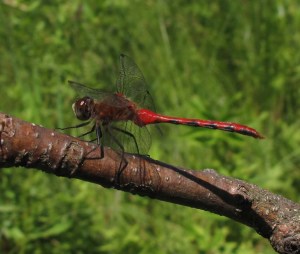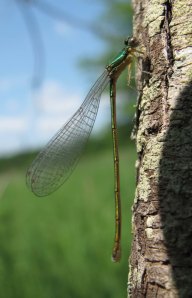Recently my PhD supervisor, Mark Forbes, and I have published a paper “A hypothesis to explain host species differences in resistance to multi-host parasites” in Ideas in Ecology and Evolution outlining a new hypothesis in testing the evolution of resistance of host-parasite associations (Forbes and Mlynarek 2014, find it here). This hypothesis outlines the reasons why certain hosts can kill their parasites while their close evolutionary relatives can’t.
Through observations of dragonflies and damselflies, we noticed that sometimes two closely related species differ in whether they are able to resist their parasites. We note three cases in this paper where one of the host species cannot kill (resistant) the parasitic mite whereas the other is a lot more resistant:
1- Sympetrum obtrusum and Sympetrum internum infected by a mite, Arrenurus planus (Forbes et al 1999) where S. internum almost always kills the infecting mites.
2- Leucorrhinia frigida and Nannothemis bella infected by a mite, limnochares americana (Lajeunesse et al 2004) where N. bella kills more their mites.
3- Nehalennia gracilis and Nehalennia irene infected by a mite, Arrenurus sp (not yet described) (Mlynarek et al 2014) where N. gracilis always kills all the infecting mites
Each of the host species that kill their mites more readily are also the host species that are less common. By less common I mean that they cannot be found in a few locations.
The obvious question is ‘why would it be that the less common species is better at getting rid of their parasites than the more common one?’ Logically, it should be the other way around. The common species, because it comes into contact with more parasites species, should be better at generally recognizing what would hurt them rather than the uncommon species that has not had the same experience. But clearly in several cases of dragonfly hosts parasitized by water mites it is not the case. But the uncommonness of the species may be where their success lies.
This paper therefore puts forth a reason for the pattern that we see. I mentioned before that each of the species that kills their parasites is present in fewer locations. When a species is in fewer locations, it probably cannot disperse or travel to other locations. So it can only breed with the other individuals of that species present at that location and this leads to less genetic mixing between populations for this species. This may benefit that species because certain individuals are successful at killing their specific parasites and then those individuals pass those traits to their off-spring and resistance can evolve with time. Whereas the common species, that can easily mix individuals between locations, may swamp out those resistance traits because there is just so much of that species everywhere.
So this hypothesis proposes that it may be good to be rare! At least it may be good to be rare to a certain extent.
References
Forbes, M.R. and J.J. Mlynarek. 2014. A hypothesis to explain host species differences in resistance to multi-host parasites. Ideas in Ecology and Evolution 7: 17-24.
Forbes, M.R., Muma, K.E. and B.P. Smith. 1999. Parasitism of Sympterum dragonflies by Arrenurus planus mites: maintenance of resistance particular to one species. International Journal of Parasitology 29: 991-999.
Lajeunesse, M.J., Forbes, M.R. and B.P. Smith. 2004. Species and sex biases in ectoparasitism of dragonflies by mites. Oikos 106: 501-508.
Mlynarek, J.J., Knee, W. and M.R. Forbes. 2014. Explaining resistance in a multi-host parasite. Evolutionary Biology 41: 115-122.



